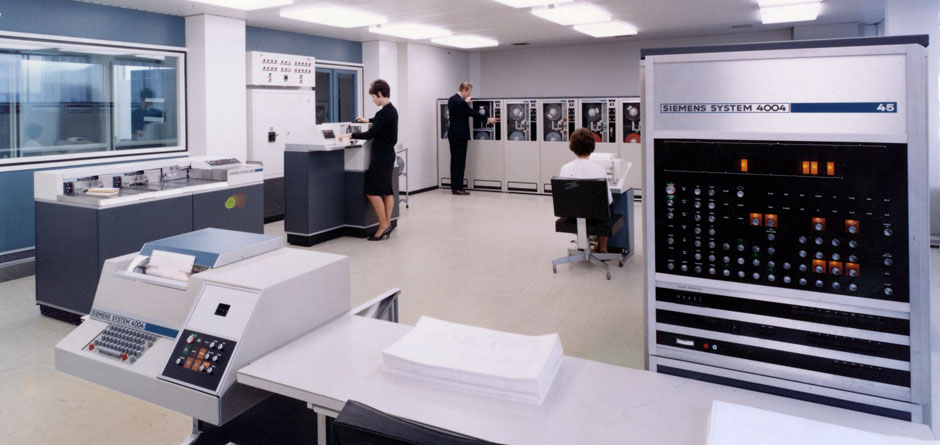Computers had entered business, industry and trade in the 1960s, but it was at the beginning of the 1970s that this process gathered momentum. One reason for this was the great leap forward in microelectronics, which led to an enormous increase in performance coupled with far smaller, cheaper computer systems. The increase in the use of computers was accompanied by major technical, organizational and social change at the workplace, which caused existing business processes to be largely adapted to electronic data processing, resulting in rapid growth in requirements for new work qualifications in offices and in manufacturing.
Companies first began to work with computer systems at the beginning of the 1960s. These systems were installed at computer centres. The operating costs of such a computer centre were so high that the systems had to run day and night to be profitable.
It was only large companies that generated such large volumes of data. Accordingly, it was large banks and insurance companies that first set up computer centres. A small number of highly respected computer specialists worked there - programmers who wrote the software and operators who ran the systems. Data that had been recorded was processed there and returned to office staff as computer printouts.
With the development of data communications equipment, it was no longer necessary to install peripheral devices in computer centre locations. Terminals at office workers' desks made it possible to enter into a dialogue with the computer, i.e. to directly access the data. In 1965, IBM launched the System/360 mainframe on the market, and finally established itself as the world's leading computer supplier. From this point on, IBM set the standards.
With the development of data communications equipment, it was no longer necessary to install peripheral devices in computer centre locations. Terminals at office workers' desks made it possible to enter into a dialogue with the computer, i.e. to directly access the data. In 1965, IBM launched the System/360 mainframe on the market, and finally established itself as the world's leading computer supplier. From this point on, IBM set the standards.
In the mid-1960s, a special approach to data processing was introduced. It was predominant in Germany, where the whole range of office computers was referred to as Mittlere Datentechnik, in English later dubbed mid-range systems. Various companies - many of them from the office machine industry, such as Kienzle and Philips, or newcomers like Nixdorf - launched special small office computers for commercial administration, tailored to meet end users' needs.
This approach was an extraordinary success because it bundled application software and customer training with the hardware. This all-in service led to the rapid spread of office computers through small and medium-sized companies, which could not afford their own data processing department and therefore wanted complete solutions for their business organization.
At the beginning of the 1970s, numerous newly founded software houses in the USA and Europe discovered this market opening and satisfied the exploding demand for application programs by developing manufacturer-independent standard software.
Minicomputers came onto the market in the USA at about the same time as office computers in Europe. The first was Digital Equipment Corporation's pdp-8, which was launched in 1965. These systems were the answer to the mainframes that had dominated the market in the USA until then, and were a great commercial success. In particular, scientists who wrote their own programs were keen on minicomputers, which made them independent of computer centres. Minicomputers and microcomputers quickly found their way from universities to the business world.
As flexible, fast process-control computers, they were used in factories from the 1970s to plan, control and automate manufacturing processes. The increase in computer-controlled manufacturing technologies was motivated by the necessity to cut costs and to ensure more efficient, flexible and cheaper production. Computer-controlled robots initially became widespread in the automotive manufacturing sector in the early 1980s. About 60% of all computers were in use there, and replaced 20 to 26% of factory workers. From there, computers penetrated the whole world of industry.
